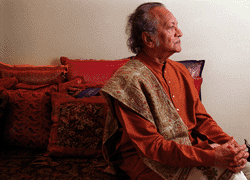Ravi Shankar
 When it comes to singing the praises of Ravi Shankar, even some of the world`s most acclaimed artists tend to sound humbled, even awe-struck.
When it comes to singing the praises of Ravi Shankar, even some of the world`s most acclaimed artists tend to sound humbled, even awe-struck. U2 singer Bono dropped his voice to a reverent hush when assessing India`s most famous instrumentalist and composer.
"He`s one of the true legends," said Bono, citing Shankar as a favorite of his band. "We listened a lot to his albums."
George Harrison is fond of hailing Shankar, the former Beatle`s close friend and teacher for 35 years, as "the godfather of World Music."
Noted trombonist and electronic-music maverick George Lewis ranks the sitar master as "one of the greatest musicians of the century."
And, English fusion-jazz guitar pioneer John McLaughlin perhaps best captures the importance of Shankar, who performed recently at Copley Symphony Hall in San Diego with his daughter, teen-age sitar prodigy Anoushka Shankar.
"Raviji single-handedly built a tremendous bridge between East and West," said McLaughlin, who studied with Shankar in the early 1970s while forming his own Indian music group, Shakti.
"He allowed people in the West, who were unaware of Indian music and culture in general, to have access to it and be exposed to it," continued McLaughlin, who performed with Shakti recently.
"And, this was wonderful. He was a messenger, not entirely in religious terms, but in cultural terms, musical terms and in terms of humanity, because he`s a great human being."
The vibrant Shankar, who looks far younger than his 80 years, is pleased to be held in such high esteem, but he prefers to focus on new projects and the future - in fact, he believes he has yet to achieve his artistic potential.
"I hate to use the word `mastery,` because I have not been able to master it yet," Shankar said, referring to the 19-stringed sitar and the various Indian classical music traditions to which he has devoted his life.
"It takes a very long time, because you don`t have any visual help, like the written scores in Western classical music. Indian classical music is an oral tradition, and you have to memorize thousands of things - compositions, melodic forms, rhythmic cycles - it`s like feeding a computer. And, then, after you learn all that, a performer can go on his own, when he is ready, and improve over the years. We learn as we go along."
India has two distinct classical music traditions - Hindustani and karnatak - which represent the country`s northern and southern cultures, respectively. The complexities of each are so great that very few Western listeners were willing, or able, to embrace them during the first half of the 20th century.
Shankar, the musical director of All-India Radio from 1949 to 1956, changed all that.
DANCES WITH INSIGHT
Beginning in the mid-1950s, he worked tirelessly to introduce the music of his native land to Europe and North America, where he`d first toured in the 1930s as a dancer and multi-instrumentalist in a troupe led by his older brother, Uday.
"Starting off as a dancer was absolutely an advantage," recalled Shankar, who made his Carnegie Hall debut in 1938 at age 18.
"Rhythm is such a vast world. If you say raga, or melody, it doesn`t express the whole thing. What interests me is all these metric patterns, or csanda, such as: Boom-ba-do-bomp, ba-da-do-bimp, biddi-biddi-boom-ba, diddi-diddi-boom. ... It`s all in (cycles of) threes. But there are little patterns you can bring out, and dance has a lot to do with that. It gave me a lot of insight."
Like no one else in Indian music, Shankar has shared his insights with audiences far and wide. He has done so without diluting the intricacies of the music or talking down to his audiences.
"It was successful from the first day in 1954 that I started performing in London and the Soviet Union, because I always explained a few basic things," he said, speaking in the airy living room of the Encinitas, Calif., home he shares with Anoushka, 19, and wife Sukanya, 46.
"I would never say enough to bore people. But I would explain what a raga is and how we don`t modulate (from key to key), as well as the descending and ascending development of the raga, and how we divide the rhythms. It didn`t take much time for audiences to catch on."
Shankar`s reputation also grew as a result of his formal and informal collaborations with an array of musicians.
Over the years, they have included such classical music giants as French flutist Jean-Pierre Rampal, Russian cellist Mstislav Rostropovich and American minimalist composer Philip Glass; such rock stars as Harrison; and progressive jazz saxophone pioneer John Coltrane, who studied with Shankar in New York, emulated him and even named his son, Ravi, after him.
"He was so special," Shankar said of Coltrane. "He wanted to know what goes on in our minds when we improvise. He wanted to know more, but I told him, very frankly, I could not help him.
"I said, `John, you have become a vegetarian, you don`t drink, you don`t do drugs, you are reading Krishna, and are so deeply interested in our music. But, how come I still find so much torment and torture in your music?` I asked him point blank.
"And, he said - and I have never told this before - `That`s the one thing I want to learn from you, more than the technique or the music itself, the feeling of peace.` You see, we also have this torment, but we bring it out in a different, much more deep, way. Not by shouting, but in soft ways. The whole theory in our music is about nine principal moods - tranquillity, peace, passion, humor, love, devotion, anger, fear and disgust. People wonder, how can we express that in instrumental music? But we do."
Shankar, who won his first Grammy Award in 1967, welcomed the opportunity to dispel a major misconception about Indian music.
"Many people have the wrong idea that our music is totally spiritual all the time, and this is not true," he said.
"There are happy, playful, erotic and romantic moments. All these things are there, and with the (tabla) drums and rhythmic excitement, we can display so much joy and fun. Then there is that whole part of exhibitionists playing to the gallery, whether in jazz, rock or flamenco, so that is also there in our music.
"But we do have a feeling of total surrender, that total sadness and crying out - as I wrote in my book - to touch the supreme feeling. It`s almost there, but it`s not. ... "
Shankar`s autobiography, "Raga Mala," was published in a limited hardbound edition in 1997. It was reissued this year in paperback.
A remarkably candid book, it offers great insights into the life of a man who has spent more than a half-century saluting and extending the traditions of his country`s music.
"This is a person who not only put Indian culture on the map, but a lot of new ideas about the power of improvisation," said trombonist and electronic music composer George Lewis, who is also a professor at the University of California at San Diego.
"What impressed a lot of people," Lewis continued, "was how aware he was of the whole world of music, and how open he was to crossing and mixing cultures. He comes up with a more global notion of what music can be. He blurs all the boundaries, and transcends national borders and cultures, without losing the sense of who he is and where he comes from. And that`s unique."
Shankar is not one to toot his own horn. But he smiles when pressed about his groundbreaking work and fearless nature, which has continued undiminished even after his quadruple bypass in 1986 and some less severe heart problems in recent years.
"I was a rebel, in many senses," he allowed. "And, it did give me greater motivation that no one (from India) had done (certain things) before me, I won`t deny that."
As for his perpetual air of joy, Shankar`s wife, Sukanya, said:
"I think it`s due to the love of so many people. When he gets sick and goes into the hospital, there are all these prayers for him. I think God is not able to take him away. Anoushka needs him a little more; we all need him more. He has so much to give, still."
Now, as his 81st birthday approaches, Shankar is preparing for yet another chapter in his life.
He is poised to move with his family from their Encinitas home, where they have lived for eight months a year for much of the past decade. Their destination is New Delhi, where the building of the long-awaited Ravi Shankar Center is nearing completion. The recent concert at Copley Symphony Hall, like most of his performances with daughter Anoushka in recent years, was a benefit for the nonprofit Ravi Shankar Foundation, under whose auspices the center is being built.
"This is going to be a place where I look forward very much to being," said Shankar, who hopes to spend his future summers in Encinitas or England.
"We`ll have a recording studio, my archives and a few - I won`t call them students - but student scholars who will work with me and keep records of our tradition. And we`ll have creative facilities where I can try out orchestrations and ballets that I have written. I like to take old mythological subjects of India, and do new interpretations."
Smiling, he nodded toward his wife, seated next to him.
"She is the moving force of the center," he said of Sukanya. "I have never been a good administrator, or good with money. Thanks to her, and the center, there will at least be a record of the things I have done.
"It is up to the people and their judgment about what they think I have been able to give. But as far as I`m concerned, I have always tried to go off the beaten path and keep the tradition; to look forward and to be conscious of the changing world.
"That has worked up to now. And it is still working."
(c) Copley News Service
advertisement

Author: George Varga
Archives
The Verve Pipe
Judy Collins
Jewel
Ben E. King
NSYNC
311
Nickel Creek
Brian Wilson
Spinal Tap
Mark Knopfler
SR-71
Stevie Nicks
Iggy Pop
Henry Threadgill
Joe Jackson
More Articles







